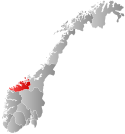Sør-Aukra
Sør-Aukra Municipality
Sør-Aukra herred | |
|---|---|
 Møre og Romsdal within Norway | |
 Sør-Aukra within Møre og Romsdal | |
| Coordinates: 62°42′49″N 06°47′46″E / 62.71361°N 6.79611°E | |
| Country | Norway |
| County | Møre og Romsdal |
| District | Romsdal |
| Established | 1 Jan 1924 |
| • Preceded by | Aukra Municipality |
| Disestablished | 1 Jan 1965 |
| • Succeeded by | Midsund Municipality |
| Administrative centre | Midsund |
| Area (upon dissolution) | |
• Total | 86 km2 (33 sq mi) |
| Population (1965) | |
• Total | 1,912 |
| • Density | 22/km2 (58/sq mi) |
| Time zone | UTC+01:00 (CET) |
| • Summer (DST) | UTC+02:00 (CEST) |
| ISO 3166 code | NO-1545[1] |
Sør-Aukra is a former municipality in Møre og Romsdal county, Norway. Sør-Aukra Municipality existed from 1924 until 1965 when it was merged into Midsund Municipality (now part of Molde Municipality). The 86-square-kilometre (33 sq mi) municipality consisted of the entire island of Otrøya, the eastern part of Midøya island, and some small surrounding islands at the entrance to the large Romsdal Fjord. The village of Midsund was the administrative centre of the municipality.[2]
History

The municipality of Sør-Aukra was established on 1 January 1924 when the old Aukra Municipality was divided into Sør-Aukra (in the south) and Nord-Aukra (in the north). Initially, Sør-Aukra Municipality had a population of 1,395.[3]
During the 1960s, there were many municipal mergers across Norway due to the work of the Schei Committee. On 1 January 1965, Sør-Aukra was merged with the island of Dryna and the rest of the island of Midøya, both from Vatne Municipality, to form the new Midsund Municipality. Prior to the merger, Sør-Aukra had a population of 1,912. At the same time, Nord-Aukra changed its name back to Aukra.[3]
Name
The municipality was created when the old Aukra municipality was divided into two: Nord-Aukra and Sør-Aukra. The prefix sør means "southern". The main part of the name comes from the old Aukra farm (Old Norse: Aukrin) since the first Aukra Church was built there. The first element is akr which means "field" or "acre". The last element is vin which means "meadow" or "pasture".[4]
Government
While it existed, this municipality was responsible for primary education (through 10th grade), outpatient health services, senior citizen services, unemployment, social services, zoning, economic development, and municipal roads. During its existence, this municipality was governed by a municipal council of directly elected representatives. The mayor was indirectly elected by a vote of the municipal council.[5]
Municipal council
The municipal council (Herredsstyre) of Sør-Aukra was made up of representatives that were elected to four year terms. The party breakdown of the final municipal council was as follows:
| Party name (in Nynorsk) | Number of representatives | |
|---|---|---|
| Labour Party (Arbeidarpartiet) | 2 | |
| Local List(s) (Lokale lister) | 15 | |
| Total number of members: | 17 | |
| Party name (in Nynorsk) | Number of representatives | |
|---|---|---|
| Labour Party (Arbeidarpartiet) | 2 | |
| Local List(s) (Lokale lister) | 15 | |
| Total number of members: | 17 | |
| Party name (in Nynorsk) | Number of representatives | |
|---|---|---|
| Labour Party (Arbeidarpartiet) | 3 | |
| Local List(s) (Lokale lister) | 14 | |
| Total number of members: | 17 | |
| Party name (in Nynorsk) | Number of representatives | |
|---|---|---|
| Local List(s) (Lokale lister) | 16 | |
| Total number of members: | 16 | |
| Party name (in Nynorsk) | Number of representatives | |
|---|---|---|
| Labour Party (Arbeidarpartiet) | 1 | |
| Communist Party (Kommunistiske Parti) | 1 | |
| Joint List(s) of Non-Socialist Parties (Borgarlege Felleslister) | 11 | |
| Local List(s) (Lokale lister) | 3 | |
| Total number of members: | 16 | |
| Party name (in Nynorsk) | Number of representatives | |
|---|---|---|
| Labour Party (Arbeidarpartiet) | 2 | |
| Communist Party (Kommunistiske Parti) | 2 | |
| Local List(s) (Lokale lister) | 12 | |
| Total number of members: | 16 | |
| Party name (in Nynorsk) | Number of representatives | |
|---|---|---|
| Labour Party (Arbeidarpartiet) | 3 | |
| Local List(s) (Lokale lister) | 13 | |
| Total number of members: | 16 | |
| Note: Due to the German occupation of Norway during World War II, no elections were held for new municipal councils until after the war ended in 1945. | ||
See also
References
- ^ Bolstad, Erik; Thorsnæs, Geir, eds. (26 January 2023). "Kommunenummer". Store norske leksikon (in Norwegian). Kunnskapsforlaget.
- ^ Store norske leksikon. "Sør-Aukra" (in Norwegian). Retrieved 23 October 2010.
- ^ a b Jukvam, Dag (1999). Historisk oversikt over endringer i kommune- og fylkesinndelingen (PDF) (in Norwegian). Statistisk sentralbyrå. ISBN 9788253746845.
- ^ Rygh, Oluf (1908). Norske gaardnavne: Romsdals amt (in Norwegian) (13 ed.). Kristiania, Norge: W. C. Fabritius & sønners bogtrikkeri. p. 300.
- ^ Hansen, Tore; Vabo, Signy Irene, eds. (20 September 2022). "kommunestyre". Store norske leksikon (in Norwegian). Kunnskapsforlaget. Retrieved 1 January 2023.
- ^ "Kommunevalgene 1963" (PDF) (in Norwegian). Oslo: Statistisk sentralbyrå. 1964. Retrieved 24 April 2020.
- ^ "Kommunevalgene og Ordførervalgene 1959" (PDF) (in Norwegian). Oslo: Statistisk sentralbyrå. 1960. Retrieved 24 April 2020.
- ^ "Kommunevalgene og Ordførervalgene 1955" (PDF) (in Norwegian). Oslo: Statistisk sentralbyrå. 1957. Retrieved 24 April 2020.
- ^ "Kommunevalgene og Ordførervalgene 1951" (PDF) (in Norwegian). Oslo: Statistisk sentralbyrå. 1952. Retrieved 24 April 2020.
- ^ "Kommunevalgene og Ordførervalgene 1947" (PDF) (in Norwegian). Oslo: Statistisk sentralbyrå. 1948. Retrieved 24 April 2020.
- ^ "Kommunevalgene og Ordførervalgene 1945" (PDF) (in Norwegian). Oslo: Statistisk sentralbyrå. 1947. Retrieved 24 April 2020.
- ^ "Kommunevalgene og Ordførervalgene 1937" (PDF) (in Norwegian). Oslo: Statistisk sentralbyrå. 1938. Retrieved 24 April 2020.

